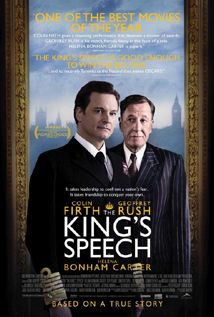Background to the Film
George VI (Albert Frederick Arthur George) was born on 14 December 1895 at York Cottage, on the Sandringham Estate in Norfolk, during the reign of his great-grandmother Queen Victoria. His father was Prince George, Duke of York (later King George V), the second and eldest-surviving son of the Prince and Princess of Wales (later King Edward VII and Queen Alexandra). His mother was the Duchess of York (later Queen Mary), the eldest child and only daughter of the Duke and Duchess of Teck. As a great-grandson of Queen Victoria, he was known formally as His Highness Prince Albert of York from birth. Within the family, he was known informally as 'Bertie'.
Plagued by a stammer from the age of 4 or 5, the young Prince Albert, Duke of York, dreaded any public speaking engagement. He tried a number of different therapies over many years. After his closing speech at the British Empire Exhibition at Wembley on 31st October 1925, one which was an ordeal for both him and the listeners, he began to see Lionel Logue, an Australian-born speech therapist. Logue did not have a medical degree, but had worked as an elocution coach in the theatre and had worked with shell-shocked soldiers after World War I. The Duke and Logue practised breathing exercises and a number of other techniques, and the Duchess (Elizabeth Bowes-Lyon, later Queen consort and Queen Elizabeth the Queen Mother) rehearsed with him patiently. With his delivery improved by the training, the Duke opened Parliament House in Canberra in 1927, and was able to speak subsequently with only a slight hesitation.
In 1936, his elder brother, Edward VIII, abdicated the throne, and Albert was thrust into the position of King. He assumed the style and title of King George VI to emphasise continuity with his father and restore confidence in the monarchy. He continued to work with Logue, and their work culminated in the King delivering a faultless speech heard around the world by radio when the UK declared war on Nazi Germany in September 1939. The King and Logue remained lifelong friends.

Formal portrait photograph of King George VI, taken during World War II





